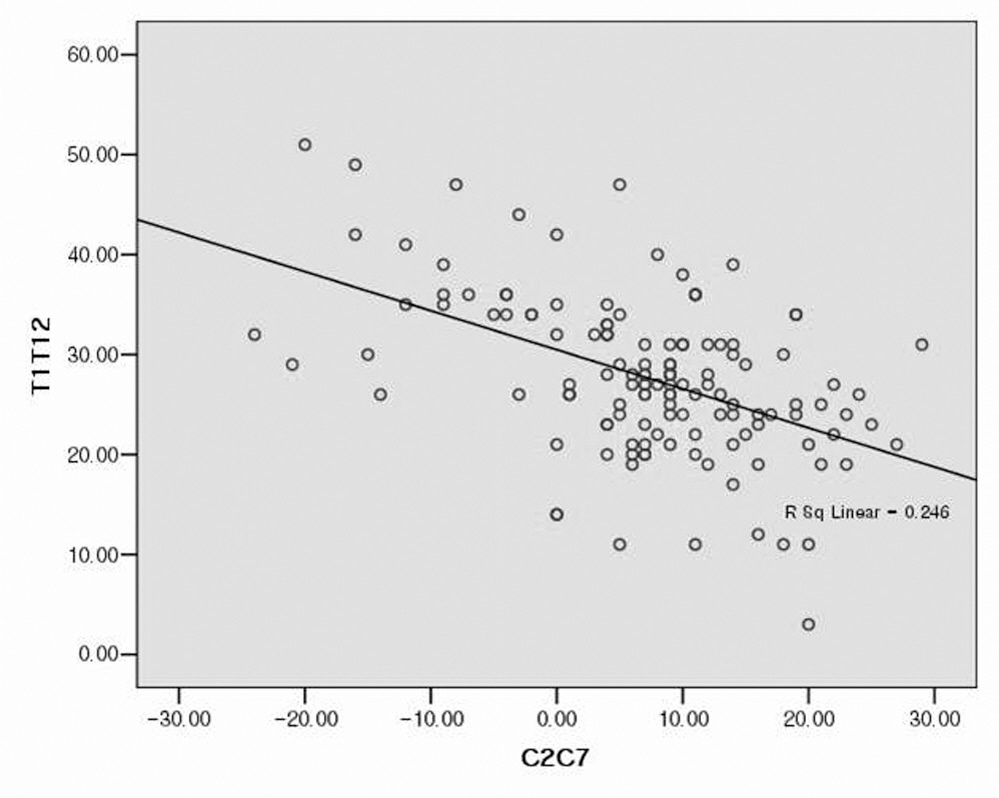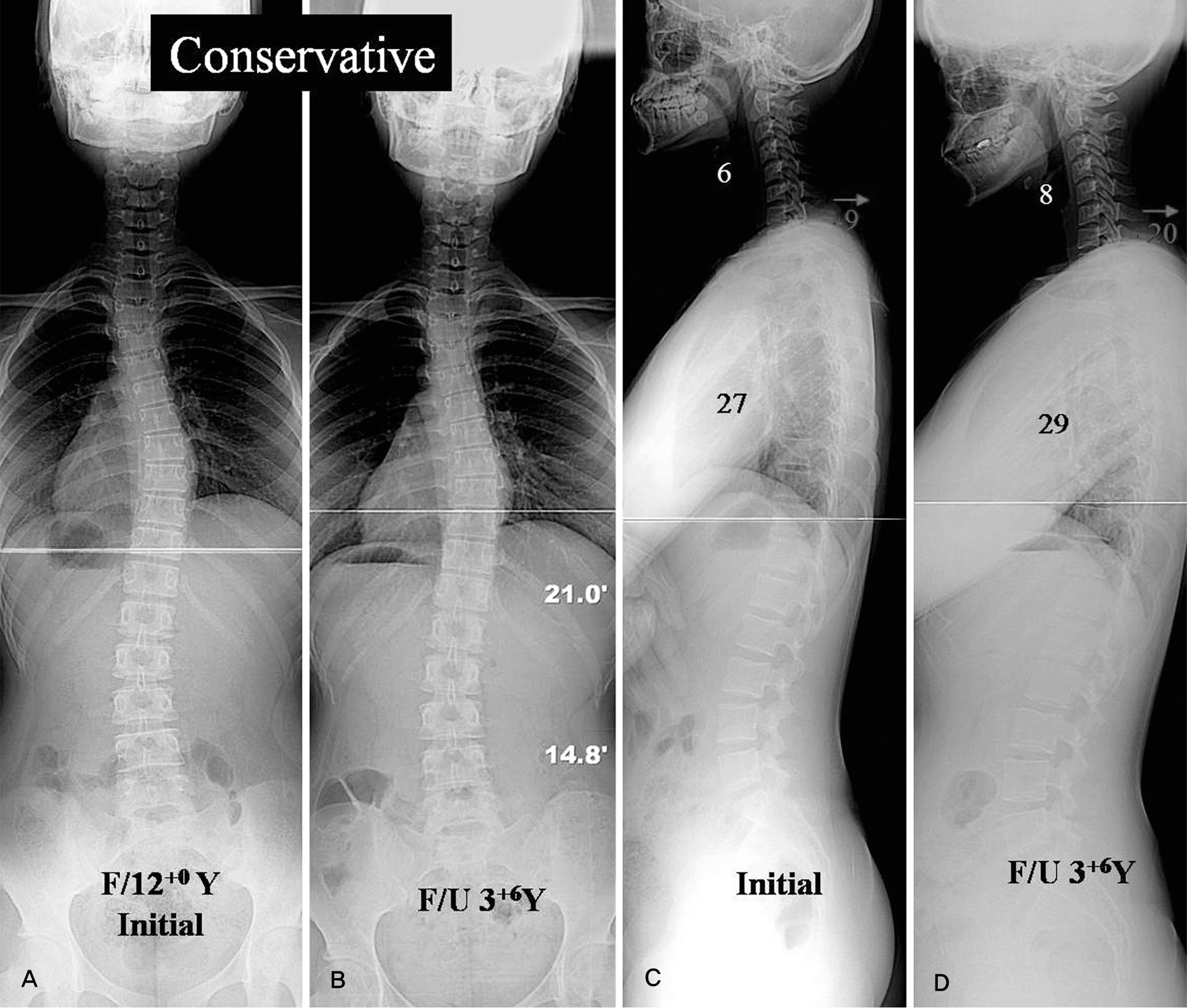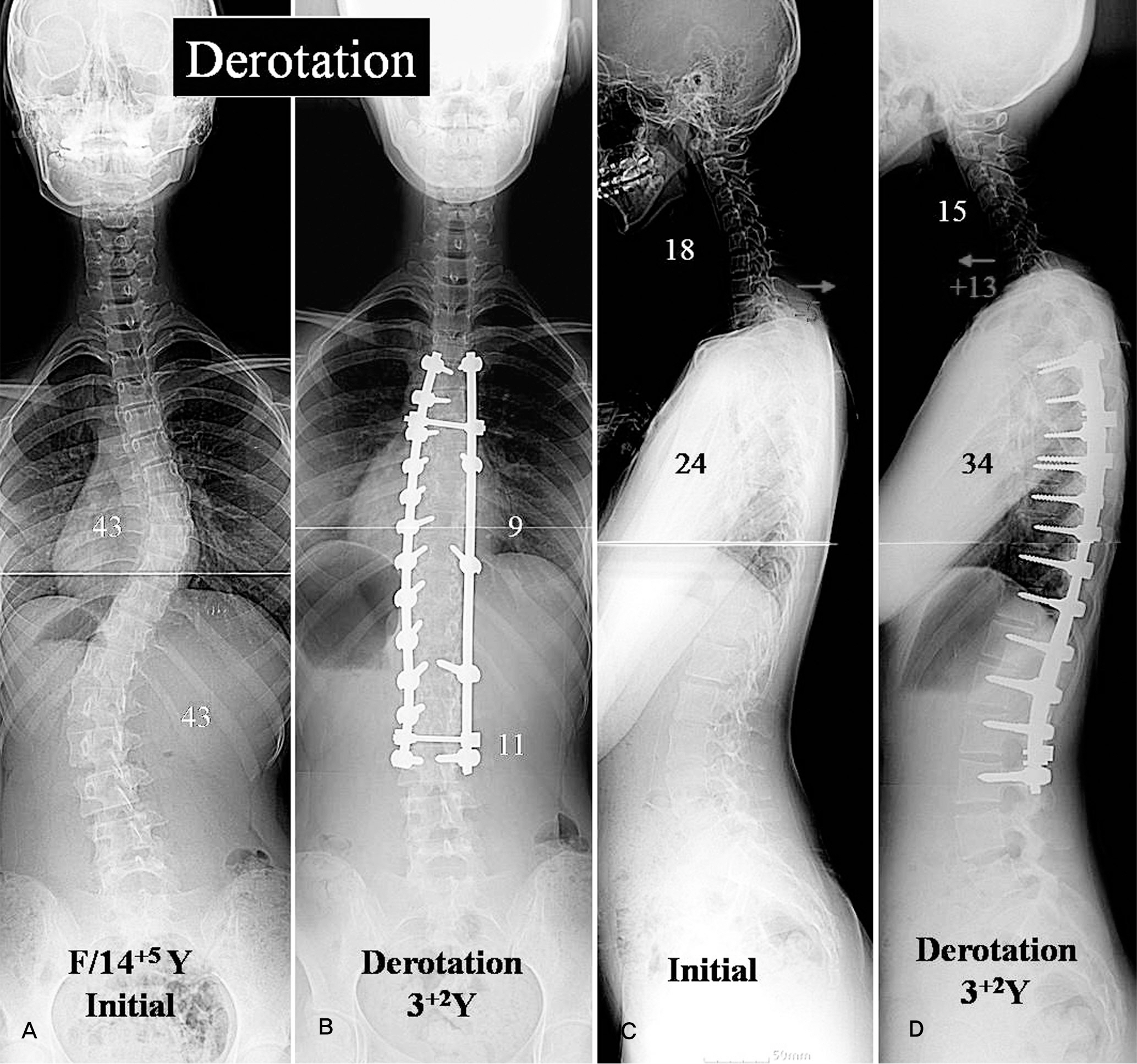J Korean Soc Spine Surg.
2013 Jun;20(2):35-43. 10.4184/jkss.2013.20.2.35.
Specific Sagittal Curve Patterns of Cervical Spine in Adolescent Idiopathic Scoliosis (AIS)
- Affiliations
-
- 1Department of Orthopedic Surgery, Cheju Halla General Hospital, Korea. snoopy5@unitel.co.kr
- 2Seoul Spine Institute, SanggyePaik Hospital, Korea.
- KMID: 1430373
- DOI: http://doi.org/10.4184/jkss.2013.20.2.35
Abstract
- STUDY DESIGN: A retrospective study.
OBJECTIVES
To evaluate the sagittal alignment of cervical spine in AIS. SUMMARY OF LITERATURE REVIEW: Little has been known about the sagittal curve patterns of cervical spine in AIS patients.
MATERIALS AND METHODS
One-hundred-thirty-three AIS patients were checked by scanographs and followed up for more than 2 years were divided into cervical kyphosis (> or =+5degrees), lordosis (< or =-5degrees) and straight (-4degrees~+4degrees) groups according to the sagittal curves of cervical spine (C2~C7). Each group was evaluated for thoracic kyphosis, lumbar lordosis, sagittal balance and Cobb's angle on coronal plane. Of the patients, 49 were treated by braces, 84 were surgically corrected (rod derotation in 52, direct vertebral rotation (DVR) in 32).
RESULTS
At the initial radiographs, cervical kyphosis was found in 97, lordosis in 23 and straight in 13 patients. In the kyphosis group, cervical kyphosis showed typical patterns of angular kyphosis. Thoracic and upper T-kyphosis (T1~T5) were lower than those in the cervical lordosis group (p=0.000, 0.001, respectively.) Other factors showed no significant differences between the groups. Patients treated by conservative management or by rod derotation had no significant differences in cervical kyphosis during the follow-up periods, though the thoracic hypokyphosis was surgically corrected. On the contrary, patients who were treated by DVR restored cervical lordosis (14/32=43.8%) from initial state showed significant differences in both conservative and rod derotation groups (p=0.008, 0.002, respectively).
CONCLUSIONS
Cervical kyphosis in AIS was a compensatory curve correlated with both thoracic hypokyphosis and rotational deformity. Rotational corrections should be considered during the surgical treatment.
Keyword
MeSH Terms
Figure
Reference
-
1. Hilibrand AS, Tannenbaum DA, Graziano GP, Loder RT, Hensinger RN. The sagittal alignment of the cervical spine in adolescent idiopathic scoliosis. J Pediatr Orthop. 1995; 15:627–32.
Article2. Canavese F, Turcot K, De Rosa V, de Coulon G, Kaelin A. Cervical spine sagittal alignment variations following posterior spinal fusion and instrumentation for adolescent idiopathic scoliosis. Eur Spine J. 2011; 20:1141–8.
Article3. Winter RB, Lovell WW, Moe JH. Excessive thoracic lordosis and loss of pulmonary function in patients with idiopathic scoliosis. J Bone Joint Surg Am. 1975; 57:972–6.
Article4. Berthonnaud E, Dimnet J, Roussouly P, Labelle H. Analysis of the sagittal balance of the spine and pelvis using shape and orientation parameters. J Spinal Disord Tech. 2005; 18:40–7.
Article5. Takeshima T, Omokawa S, Takaoka T, Araki M, Ueda Y, Takakura Y. Sagittal alignment of cervical flexion and extension: lateral radiographic analysis. Spine (Phila Pa 1976). 2002; 27:E348–55.6. Penning L. Acceleration injury of the cervical spine by hy-pertranslation of the head: effect of normal translation of the head on cervical spine motion. Eur Spine J. 1992; 1:7–19.7. Faro FD, Marks MC, Pawelek J, Newton PO. Evaluation of a functional position for lateral radiograph acquisition in adolescent idiopathic scoliosis. Spine (Phila Pa 1976). 2004; 29:2284–9.
Article8. Marks M, Stanford C, Newton P. Which lateral radiographic positioning technique provides the most reliable and functional representation of a patient's sagittal balance? Spine (Phila Pa 1976). 2009; 34:949–54.
Article9. Bernhardt M, Bridwell KH. Segmental analysis of the sagittal plane alignment of the normal thoracic and lumbar spines and thoracolumbar junction. Spine (Phila Pa 1976). 1989; 14:717–21.
Article10. Harrison DE, Harrison DD, Janik TJ, Holland B, Siskin LA. Slight head extension: does it change the sagittal cervical curve? Eur Spine J. 2001; 10:149–53.
Article11. Erkan S, Yercan HS, Okcu G, Ozalp RT. The influence of sagittal cervical profile, gender and age on the thoracic kyphosis. Acta Orthop Belg. 2010; 76:675–80.12. Lee SM, Suk SI, Chung ER. Direct vertebral rotation: a new technique of three-dimensional deformity correction with segmental pedicle screw fixation in adolescent idiopathic scoliosis. Spine (Phila Pa 1976). 2004; 29:343–9.
Article
- Full Text Links
- Actions
-
Cited
- CITED
-
- Close
- Share
- Similar articles
-
- Cervical and Thoracic Sagittal Curves in Thoracic Adolescent Idiopathic Scoliosis
- Etiology of Adolescent Idiopathic Scoliosis: A Literature Review
- Normal Age-Adjusted Sagittal Spinal Alignment Is Achieved with Surgical Correction in Adolescent Idiopathic Scoliosis
- Comparison of Proximal Fusion to T1 or T2 in Double Thoracic Adolescent Idiopathic Scoliosis
- Preoperative Magnetic Resonance Imaging Evaluation in Patients with Adolescent Idiopathic Scoliosis





